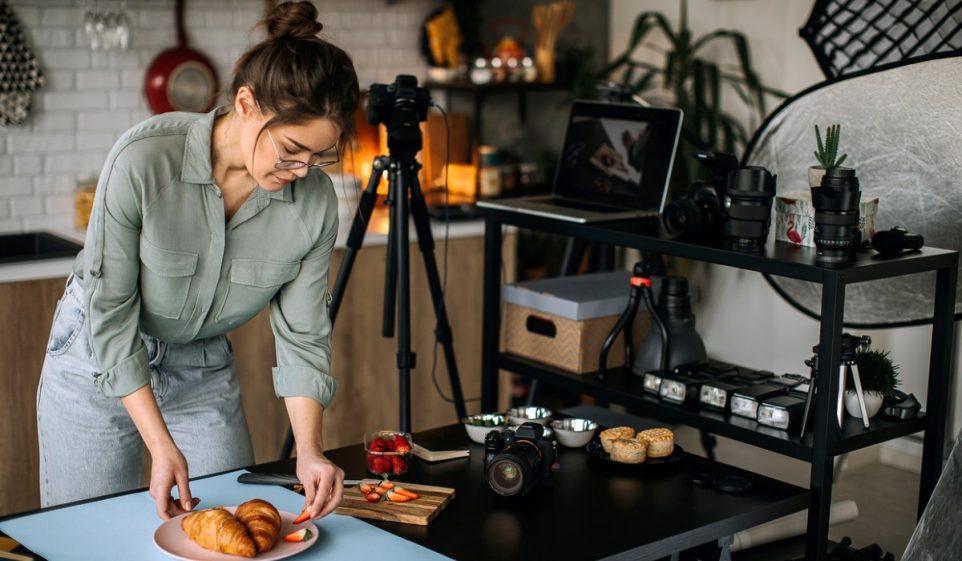A Beginner’s Guide to Becoming a Food Photographer

Are you the kind of person who spends more time capturing the perfect angle of your food than actually eating it? Do you find yourself scrolling through Instagram, drooling over the stunning food photos that make your taste buds tingle? Well, you might just be destined to become a food photographer! If you’re new to the world of photography but want to take the culinary world by storm, this beginner’s guide has everything you need to get started.
Understanding Food Photography
Food photography is the art of capturing visually appealing images of food, often for commercial or artistic purposes. It showcases various dishes’ beauty, texture, and details through carefully composed photographs. Food photography also plays a vital role in the culinary industry as it entices and attracts customers. It helps promote restaurants, cafes, food products, and even recipes. High-quality food photographs can significantly impact marketing campaigns, menus, cookbooks, and social media presence.
Food photography encompasses various styles and approaches, including:
- Commercial food photography for advertisements and packaging.
- Editorial food photography for magazines, cookbooks, and websites.
- Food blogging, where bloggers document their culinary experiences and share recipes through captivating visuals.
Essential Equipment for Food Photography
DSLR (Digital Single-Lens Reflex) and mirrorless cameras are suitable for food photography. DSLR cameras offer versatility, advanced controls, and a wide range of lens options. On the other hand, Mirrorless cameras are more compact, lighter, and often offer excellent image quality. When choosing a camera for food photography, consider features such as a high-resolution sensor, manual mode capabilities, RAW file support, and a tilting or articulating LCD screen for easy composition.
Prime lenses with fixed focal lengths are also popular among food photographers for their sharpness, wide apertures, and ability to capture fine details. Zoom lenses offer versatility and allow you to experiment with different focal lengths. Using a sturdy tripod is also essential in food photography as it eliminates camera shake and allows for precise composition and longer exposures if needed.
Additionally, investing in a collection of props, including plates, utensils, napkins, and various backgrounds, can elevate the visual appeal of your food photographs. Styling tools like tweezers, brushes, and spray bottles can help arrange and enhance the presentation of the food.
Mastering Food Styling
Food styling is essential in food photography as it helps create visually appealing compositions. It involves arranging, garnishing, and presenting the food in an attractive and appetizing manner.
- Select props and backgrounds that complement the food and evoke the desired mood or theme. Consider colors, textures, and patterns that enhance the overall composition.
- Experiment with different plating techniques and arrangements to create visually pleasing compositions. Use balance, symmetry, and the rule of thirds to guide your placement of food items.
- Garnishes and decorations can add depth, texture, and visual interest to food photographs. Experiment with herbs, sauces, spices, edible flowers, and other decorative elements to enhance the presentation.
- Highlighting textures and patterns can make food photographs more engaging. Use ingredients with contrasting textures, such as crunchy seeds on a smooth surface, or create patterns with repetitive food items.
Lighting Techniques
Natural light is often preferred in food photography for its soft, diffused quality. However, artificial lighting can be useful for controlling and enhancing lighting conditions, especially when shooting indoors or during low-light situations. Be sure to shoot during hours of warm and soft light and avoid shooting under harsh midday sunlight, which can create strong shadows.
Composition and Framing in Food Photography
Understanding the basic principles of composition is crucial in creating visually appealing food photographs. Place key elements of the composition along these gridlines or at their intersections to create a balanced and visually pleasing image. Also, consider the colors, shapes, and textures of the food and props when composing your shot. Balance these elements to create a harmonious and visually interesting image.
Lastly, explore different angles and perspectives to create unique and visually captivating food photographs. Experiment with overhead shots, close-ups, and creative angles to add variety and interest to your portfolio.
Editing Tips
Post-processing plays a crucial role in enhancing and refining food photographs. It allows you to adjust exposure, colors, sharpness, and overall tone to achieve your desired look. Choose a photo editing software that suits your needs and budget. Popular options include Adobe Lightroom, Capture One, and Affinity Photo. These programs offer a range of tools and features to enhance and edit your images effectively.
Our Recipe for Trust: Why Choose Kitchen Institute
At the Kitchen Institute, we're dedicated to providing reliable and accurate information on cooking trends, tips, and product reviews. Our team of passionate food enthusiasts ensures that every piece of content is thoroughly researched and based on real-world experience. We pride ourselves on our comprehensive and unbiased product reviews, rigorous research processes, and commitment to staying current with the latest culinary innovations. Trust us to enhance your culinary journey with quality insights and practical advice.